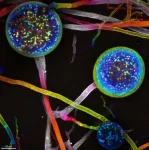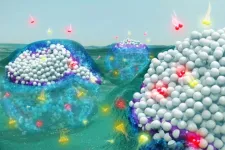INFORMATION:
Other contributors of this work include Letisha Aideyan, Xunyan Ye, Vasanthi Avadhanula and Laura Ferlic-Stark, all at Baylor.
Financial support of this study was provided by discretionary funds and NIH grant R01GM115501.
Duration of antibody response varies among adults naturally reinfected with RSV
2021-02-04
(Press-News.org) Researchers at Baylor College of Medicine found that while most individuals responded to respiratory syncytial virus (RSV) natural reinfection with a typical sustained antibody response associated with protection, a few individuals surprisingly responded atypically, not being able to sustain the antibody response, which declined to levels that made the individuals susceptible to RSV reinfection.
The researchers highlight in their study, published in the journal Vaccine, that their findings point at a subpopulation of people who also may not maintain an antibody response to vaccines and suggest the need to characterize patient-specific responses to respiratory viral infections, such as COVID-19.
"RSV is the leading cause of childhood acute lower respiratory illness worldwide and a significant cause of morbidity and mortality in older adults," said corresponding author Dr. Pedro A. Piedra, professor of molecular virology and microbiology, pediatrics and of pharmacology and chemical biology at Baylor. He also is the director of Baylor's Clinical Laboratory Improvement Amendments (CLIA)-Certified Respiratory Virus Diagnostic Laboratory. Piedra also is a leader in the fight against COVID-19.
In response to RSV infection, the body produces specific antibodies that have been correlated with protection from infection and reduction of severe disease, but reinfection is still frequent.
"To understand RSV reinfection, we studied the levels of the natural RSV-specific antibody response on an adult population during an RVS season in Houston," said first author Brittani N. Blunck, graduate student in the Piedra lab.
The researchers found that the 19 individuals they studied could be placed in one of three categories according to their antibody profiles: A) those whose RSV antibody profile did not change, an indication that they did not get reinfected during the study period. B) those who showed an increase in RSV antibodies, a typical response showing that they had a reinfection that boosted the antibody response, and C) a surprising, small group that showed good antibody levels at the beginning of the study followed by a quick decline in antibodies to levels that made them susceptible to reinfection.
The 'original antigenic sin'
"The other important finding was what we call the 'original antigenic sin,'" Piedra said. "This phenomenon, which has been demonstrated for the influenza virus and others, refers to the immune system responding more to older infections than to recent infections."
In this original antigenic sin case, the immune system produced a stronger antibody response to RSV strains it had encountered long ago than to other strains of the same virus it encountered more recently.
"That was surprising but not totally unexpected because we see that with other viruses. However, we had not seen that for RSV before," Piedra said.
"We think that our main findings, the existence of a small portion of a human population that does not sustain an RSV antibody response after reinfection and the original antigenic sin, have important implications for vaccine development and deserve further study," Blunck said.
"Understanding natural reinfection is essential for vaccine development because it helps us design more effective vaccines," said co-author Dr. E. Lynn Zechiedrich, Kyle and Josephine Morrow Chair in Molecular Virology and Microbiology at Baylor.
"This study is also relevant to the current COVID-19 epidemic, as in some ways RSV and SASRS-Cov-2 are similar," said co-author Dr. Brian Gilbert, associate professor of molecular virology and microbiology at Baylor. "We need more detailed studies on the immune responses to SARS-CoV-2, the virus that causes COVID-19."
The researchers are continuing their studies by investigating the responses of other branches of the immune system, such as the cellular immune response, to RSV reinfection, as well as the mechanism that mediates the atypical antibody response observed in this work.
ELSE PRESS RELEASES FROM THIS DATE:
'Audeo' teaches artificial intelligence to play the piano
2021-02-04
Anyone who's been to a concert knows that something magical happens between the performers and their instruments. It transforms music from being just "notes on a page" to a satisfying experience.
A University of Washington team wondered if artificial intelligence could recreate that delight using only visual cues -- a silent, top-down video of someone playing the piano. The researchers used machine learning to create a system, called Audeo, that creates audio from silent piano performances. When the group tested the music Audeo created with music-recognition ...
In symbiosis: Plants control the genetics of microbes
2021-02-04
Researchers from the University of Ottawa have discovered that plants may be able to control the genetics of their intimate root symbionts - the organism with which they live in symbiosis - thereby providing a better understanding of their growth.
In addition to having a significant impact on all terrestrial ecosystems, their discovery may lead to improved eco-friendly agricultural applications.
We talked to research lead Nicolas Corradi, Associate Professor in the Department of Biology and Research Chair in Microbial Genomics at the University of Ottawa, ...
Experimental vaccine blunts the deadliest of synthetic opioids
2021-02-04
LA JOLLA, CA--As the opioid epidemic raged on with an even greater force during COVID-19, the Scripps Research laboratory of chemist Kim Janda, PhD, has been working on new therapeutic interventions that may be able to prevent the bulk of deaths from opioid overdose.
Janda and his team have developed experimental vaccines that have shown in rodents to blunt the deadly effects of fentanyl--which has been driving the boom in opioid deaths--as well as its even more fatal cousin, carfentanil, a growing source of overdoses and a chemical terrorist threat.
"Synthetic opioids are not only extremely deadly, but also addictive and easy to manufacture, making them a formidable public health threat, especially when the coronavirus crisis is negatively impacting mental health," says Janda, the Ely ...
Switching nanolight on and off
2021-02-04
A team of researchers led by Columbia University has developed a unique platform to program a layered crystal, producing imaging capabilities beyond common limits on demand.
The discovery is an important step toward control of nanolight, which is light that can access the smallest length scales imaginable. The work also provides insights for the field of optical quantum information processing, which aims to solve difficult problems in computing and communications.
"We were able to use ultrafast nano-scale microscopy to discover a new way to control our crystals with light, turning elusive photonic properties on and off at will," said Aaron Sternbach, postdoctoral researcher ...
Scientists establish multiple primate models of SARS-CoV-2 airborne infection
2021-02-04
Army scientists evaluated three nonhuman primate species as potential models of SARS-CoV-2 airborne infection, according to results published online this week in PLOS ONE. Their work demonstrates that any of these species may be useful for testing vaccines and therapies in response to the COVID-19 pandemic, which has resulted in over 104 million cases and more than 2 million deaths worldwide in the past year.
Given the global impact of COVID-19, experts are working rapidly to develop medical countermeasures, and testing in animal models is critically important to evaluate the efficacy of these products. Recent studies suggest that aerosol ...
New test provides fast and accurate diagnosis of liposarcomas
2021-02-04
Philadelphia, February 4, 2021 - Researchers have leveraged the latest advances in RNA technology and machine learning methods to develop a gene panel test that allows for highly accurate diagnosis of the most common types of liposarcoma. It quickly and reliably distinguishes benign lipomas from liposarcomas and can be performed in laboratories at a lower cost than current "gold standard" tests. The new assay is described in The Journal of Molecular Diagnosis, published by Elsevier.
"Liposarcomas are a type of malignant cancer that is difficult to diagnose because, even under a microscope, it is hard to differentiate liposarcomas from benign tumors or other types ...
New study examines addiction medicine treatment in Vietnam
2021-02-04
An assessment published this week in the journal The Lancet HIV provides new insight about an initiative to integrate treatment of opioid use disorder along with HIV in Vietnam.
The study marks one of the first scientifically robust assessments of a new model of treating HIV in lower or middle income countries where injection drug use is a major cause of HIV infection. It also suggests the importance of building support for peer and community connections to tackle the opioid epidemic that continues to ravage the United States in the midst of the COVID-19 pandemic.
The study was led by scientists and physicians at Hanoi Medical University and Oregon Health & Science University.
"Our study suggests that countries that ...
Imaging the first moments of a body plan emerging in the embryo
2021-02-04
WOODS HOLE, Mass. -- Egg cells start out as round blobs. After fertilization, they begin transforming into people, dogs, fish, or other animals by orienting head to tail, back to belly, and left to right. Exactly what sets these body orientation directions has been guessed at but not seen. Now researchers at the Marine Biological Laboratory (MBL) have imaged the very beginning of this cellular rearrangement, and their findings help answer a fundamental question.
"The most interesting and mysterious part of developmental biology is the origin of the body axis in animals," said researcher Tomomi Tani. An MBL scientist in the Eugene Bell Center at the time of the research, Tani is now with Japan's National Institute of Advanced Industrial Science and Technology.
The work by Tani and ...
Mysterious organic scum boosts chemical reaction efficiency, may reduce chemical waste
2021-02-04
CHAMPAIGN, Ill. -- Chemical manufacturers frequently use toxic solvents such as alcohols and benzene to make products like pharmaceuticals and plastics. Researchers are examining a previously overlooked and misunderstood phenomenon in the chemical reactions used to make these products. This discovery brings a new fundamental understanding of catalytic chemistry and a steppingstone to practical applications that could someday make chemical manufacturing less wasteful and more environmentally sound.
The study led by University of Illinois Urbana-Champaign researcher David Flaherty, University of Minnesota, Twin Cities researcher Matthew Neurock and Virginia Tech researcher Ayman Karim is published in the journal Science.
Combining ...
An optical coating like no other
2021-02-04
For more than a century, optical coatings have been used to better reflect certain wavelengths of light from lenses and other devices or, conversely, to better transmit certain wavelengths through them. For example, the coatings on tinted eyeglasses reflect, or "block out," harmful blue light and ultraviolet rays.
But until now, no optical coating had ever been developed that could simultaneously reflect and transmit the same wavelength, or color.
In a paper in Nature Nanotechnology, researchers at the University of Rochester and Case Western Reserve University describe a new class of optical coatings, so-called Fano Resonance Optical Coatings (FROCs), that can be used on filters to reflect and transmit colors of remarkable purity.
In addition, ...




